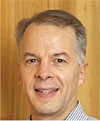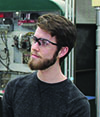March/April 2020
Climate Changers
BY EVA KAPLAN-LEISERSON
Glaciers melting, seas rising, hurricanes strengthening, droughts intensifying, wildfires spreading. These are just a sampling of the global effects tied to climate change. And, as they proliferate, the engineering profession is taking notice.
Although adaptation has been engineers’ primary area of focus, mitigation is receiving growing attention. Among the drivers: young engineers who have grown up thinking about their personal impacts, and who derive inspiration from peers at the forefront of global climate movements.
Sounding the Alarm
In December 2019, the World Federation of Engineering Organizations published a “Declaration on Climate Emergency.” It pointed to the significant impacts of systems such as transportation, energy, water, and waste on carbon dioxide emissions and natural habitats.
Engineering’s “primary purpose has always been progressing and enhancing the societal well-being,” read the declaration. But, it emphasized, “for everyone working in the construction and infrastructure industries, it has now become clear that meeting the needs of our society without breaching the earth’s ecological boundaries will demand a paradigm shift.”
According to the WFEO, that includes designing buildings, cities, and infrastructure systems as components of a large system in balance with wider society and the natural world. Specific goals include further development of climate mitigation and adaptation principles and adopting design principles that enable net zero economies by 2050.
Those goals are directly in line with the perspectives of many younger engineers who feel driven to help address the crisis.
The Engineer’s Responsibility
 ROSALEEN NOGLE, P.E.
ROSALEEN NOGLE, P.E.Rosaleen Nogle, P.E., is a 37-year-old assistant principal engineer at the Buffalo (New York) Sewer Authority and an NSPE member. She believes engineers have a responsibility to mitigate climate change in both their personal and professional lives.
Nogle tries to bike or walk when possible, chooses vegetarian meals at professional banquets, and, as an Episcopal deacon, has preached sermons on climate change and “the moral duty to mitigate one’s personal impacts.”
Beyond the overall human responsibility, she points to engineers’ particular imperative to design sustainable systems and projects, due to their “educational and practical ability” that’s lacking in the general public.
At the Buffalo Sewer Authority, Nogle works on projects to reduce fossil fuel usage through more conscientious use of natural gas and electricity and on solar energy development. For example, the authority is looking at installing solar panels on its roof and exploring capturing methane from its digestion process to use for heat and power.
If all of us don’t work towards mitigation, she says, “then the world our children and grandchildren are going to be living in is going to be a really scary place.”
 JENNA LAUBE, P.E.
JENNA LAUBE, P.E.Jenna Laube, P.E., graduated from college in 2009. She’s now an environmental engineer for Textron Systems, which focuses on defense, government, and aerospace technologies and services. She sits on her company’s global Sustainability Steering Committee, reads reports from the Maryland Commission on Climate Change, and attends events such as Maryland’s Environmental Legislative Summit. She explains that Textron seeks ways to reduce its energy consumption, waste, water use, and overall greenhouse gas emissions.
“Without a doubt,” says the professional engineer, “engineers have a duty to mitigate climate change.” According to Laube, every system, machine, and building should be designed and manufactured with environmental considerations included from the beginning. “We used ‘design for X,’” Laube says, “and the X criteria has pretty much always been performance, reliability, cost. But, increasingly, environment is getting added to the list.”
In addition, Laube emphasizes, engineers have a social responsibility to mitigate climate change because the populations and countries who can’t afford to retrofit will be the ones most affected.
 MILES GRUBBS, P.E.
MILES GRUBBS, P.E.Thirty-five-year-old Miles Grubbs, P.E., is a mechanical engineer at international architecture and design firm Little. The company has worked on dozens of LEED-certified projects, is developing a sustainability action plan to address various aspects of high-performance design, and has signed onto a challenge to firms from the American Institute of Architects to make new buildings and major renovations carbon neutral by 2030.
“I strongly believe that engineers have a responsibility to help mitigate the effects of climate change,” Grubbs says. “We not only helped create the problem since the advent of the industrial revolution and engineering as a profession, we’ve promised to hold paramount the public’s safety, health, and welfare.”
Regardless of their industry, he continues, engineers can make a positive and lasting impact; for example, by improving engine fuel efficiency, designing more efficient solar panels, or improving manufacturing techniques.
Grubbs believes that younger employees, who grew up with a focus on “reduce, reuse, recycle,” tend to view climate change response as a necessary component of their work. For example, in building design, climate change mitigation is just another aspect of design to consider, he says. An engineer’s role could include increasing energy efficiency and educating building owners and maintenance staff.
Even smaller projects offer the opportunity to push the envelope a bit, the PE says, while still remaining mindful of the client’s budget. Sustainable, high-performance projects also tend to offer better end results, Grubbs says, because they require so much collaboration and coordination across trades.
Competitive Advantage
Companies that consider climate effects in their work not only make a positive impact but also may have an easier time recruiting and retaining young talent.
 JEFF ROMAN, P.E.
JEFF ROMAN, P.E.As Jeff Roman, P.E., partner and engineering practice leader at Little, says, “the younger generation wants to work for a firm that they see making a difference.” The NSPE member believes that both Little’s commitment to sustainability and ability of staffers to discuss specific examples of projects they’ve worked on help make the firm more attractive to young professionals. In addition, he says, summer intern candidates are increasingly asking about projects they would be involved with that “essentially will make the world a better place.”
Roman also points to Little’s new office in Charlotte, North Carolina, which is LEED-certified and in an urban location that offers mass transit options—noting the importance of “walking the talk.”
“I do think [Little’s emphasis on these issues] gives us an edge in recruiting that energetic young talent,” Roman says. Miles Grubbs agrees that it was “100%” the case for him, citing the firm’s participation in the AIA challenge as a key factor in his joining it.
Jenna Laube says environmental responsibility is her number one factor for evaluating any new position. “If a company doesn’t have leadership buy-in and policies to support sound environmental practices,” she explains, “it’s an immediate deal-breaker.”
And Rosaleen Nogle puts it this way: “Being able to demonstrate to my sons that the work I am doing is helping to make the world they live in better makes me want to go to work in the morning.” She would only want to join companies that consider climate change in their work, she says. “I think when we work on projects at places that aren’t accounting for climate change, we’re doing a disservice to…and imperiling our future.”
Up-and-Coming
Nogle doesn’t see her perspectives as unique among engineers her age, but she says they’re not as common as among the even younger set—those under 30.
 PAUL CROVELLA, P.E.
PAUL CROVELLA, P.E.Paul Crovella, P.E., is an assistant professor in the Department of Sustainable Resources Management at the State University of New York. While conceding that the population of students he works with are rather self-selecting, he says that with each year he is seeing students who are “more engaged, more interested, more driven to work on problems that they feel have a real significance to the future.”
When they consider their careers, he says, “they’re not thinking about their role as an engineer sitting in an office, thinking about the impact on the bottom line. They’re sitting in their dorm room thinking about what will be the impact on my future here on the planet.”
A growing number of students at SUNY have been participating in the Solar Decathlon competition. The US Department of Energy initiative challenges student teams to design and build efficient, renewable-energy-powered buildings.
The first year, Crovella says, he had to convince students to join the team. The last couple of years, the students have been self-motivated and there are “essentially too many volunteers.”
In addition, the PE continues, the students involved are focused on their personal impact—for instance, insisting that everyone carpool to off-campus activities. The students, he explains, “are interested in trying to create a future trajectory that’s positive versus one that deals with an overwhelming list of negatives and how to adjust for those negative conditions.”
 QUINLAN HOOKER
QUINLAN HOOKERQuinlan Hooker, a senior mechanical engineering student at Syracuse University, participated in the Solar Decathlon as energy team leader.
“The engineer has always been someone who creates and innovates,” says Hooker. He believes that climate change will drive the next large-scale revolution in engineering on par with the industrial revolution.
But Hooker says he didn’t have classes in his major that specifically addressed climate change, and he wishes he had more insight into mitigation and how engineers can help. He wants colleges and universities to catch up.
Crovella says traditionally engineers have compartmentalized their work. They took their responsibilities seriously, but their training was more along the lines of “How do we design a structure to withstand an earthquake” than figuring out “Why are there earthquakes?” But an awakening is happening, he says, in which engineers are realizing the impact of their decisions—for example, that of materials used.
 JAMES D'ALOISIO, P.E.
JAMES D'ALOISIO, P.E.NSPE member James D’Aloisio, P.E., who presented a series of “Climate Action for Engineers” webinars for the Society, believes the movement for curriculum related to climate change and sustainability has been evolving quickly. “Just a few years ago,” he says, “most schools had sustainability in their curriculum, but it was treated with a rather broad brush.” Now, he adds, curricula are drilling down to the specifics on what engineers need to know about emissions from projects.
It’s a “moving target,” he says. Environmental Product Declarations, independently verified documents showing information about the lifecycle environmental impacts of products, are now enabling simple ways of quantifying emissions. Incorporating that information into design parameters, as opposed to simply focusing on the least expensive solution, is now teachable at the undergraduate level, D’Aloisio says.
The Association for the Advancement of Sustainability in Higher Education offers a Sustainability Tracking, Assessment, and Rating System (STARS), based on the number of courses at an institution that include or are focused on the topic. Ratings range from platinum to bronze to “reporter.”
 NATHAN HENGY
NATHAN HENGYNathan Hengy, class of 2020, is majoring in environmental resources engineering with a minor in sustainable construction at SUNY College of Environmental Science and Forestry. But he believes that these issues should be on the minds of everyone in the profession. His education has emphasized the engineer’s duty to the public, he says, and because climate change will continue to cause damage, “I see it as something very important for all disciplines to consider.”
Building resilient systems may seem easier, he notes, because huge changes aren’t required. But he sees a greater emphasis on mitigation and changing systems among his peers. Hengy also observes a growing public demand in this direction, driven by the global youth climate movements.
Like their counterparts already in the workplace, both Hengy and Hooker express a strong desire to work for companies taking action on climate change mitigation. To completely ignore it, Hooker says, is a red flag.
Hengy, who hopes to go into green building design, realizes that “things are only going to get worse if we keep doing what we’re doing.” He doesn’t want to work for a “status quo firm,” he says, emphasizing that if he’s not part of the solution, then he’s part of the problem.
Ethical Duty?
Do engineers have an ethical duty to address climate change? In a 2018 PE article, D’Aloisio argued that “the potential consequences of anthropogenic climate change are so severe that it is unethical for engineers to ignore.”
He continued: “To dismiss or ignore this situation is to deny the deepest and truest nature of our calling as engineers. The answers can and will come from within our profession.”
Jenna Laube believes that engineers who don’t know the environmental effects of their work are dropping the ball. “It’s in the Obligation of the Engineer and it’s in our creed,” she says. “We have to place public welfare above all other considerations.”
Jeff Roman also calls out the oft-quoted phrase from NSPE’s Code of Ethics. “Under protecting the health, safety, and welfare of the public comes protecting the environment, natural resources, and designing in a sustainable way,” he says. “I think it’s inherent in what we should be doing.”
It can be tough, though, says Rosaleen Nogle, for engineers who have worked their whole careers on improving the human condition to now come to terms with the climate effects that work may have had.
She suggests that younger engineers can lead the way not only through their personal choices but also by asking questions and making suggestions in their professional lives. For instance, they can ask, “Do we want to consider Envision or LEED certification for this project?”
D’Aloisio is happy that young engineers are taking the problem seriously and bringing it to the attention of their more experienced colleagues. But, he points out, “it’s going to take all of us.”
Early in his career, the PE says, “it was all I could do to work on my projects and accomplish the goals of the client…. I was still getting acclimated to my role as an engineer.” The contributions of engineers with more experience in engineering systems and projects are needed to help move the dial in reducing emissions, he says.
As Miles Grubbs puts it, these considerations should be considered paramount, because “if we’re not doing it now, we may not be able to do it much longer.”
Learn More
- NSPE’s Sustainability and Resilience webpage;
- “Declaration on Climate Emergency”;
- AIA 2030 Commitment;
- Environmental Product Declarations;
- Association for the Advancement of Sustainability in Higher Education;
- Envision rating system.
NSPE on Sustainability and the Environment
In 2006, NSPE added a new professional obligation to the Society’s Code of Ethics recognizing the importance of sustainability. It stated, “Engineers are encouraged to adhere to the principles of sustainable development in order to protect the environment for future generations.”
NSPE Professional Policy No. 05 on the Environment, adopted in 2018, notes, “It is the policy of NSPE that licensed professional engineers be good stewards of the environment in order to protect the environment for future generations. NSPE recognizes that attention to preserving and improving the environment is critical to the sustainability of the planet and is an integral part of the practice of engineering. NSPE advocates for the inclusion of licensed professional engineers in all engineering aspects related to the environment.”


